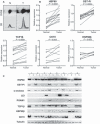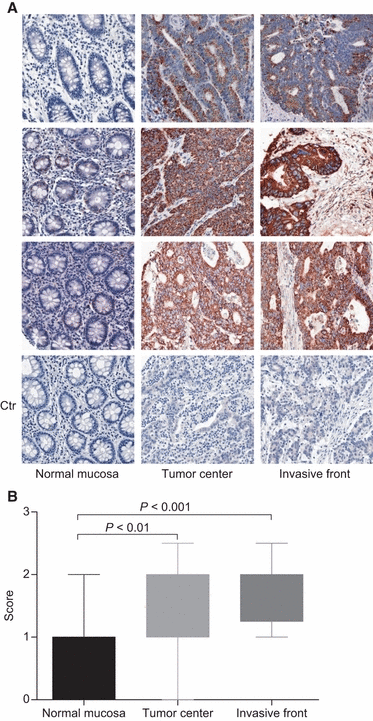Identification and verification of heat shock protein 60 as a potential serum marker for colorectal cancer
- PMID: 21973086
- PMCID: PMC3265716
- DOI: 10.1111/j.1742-4658.2011.08385.x
Identification and verification of heat shock protein 60 as a potential serum marker for colorectal cancer
Abstract
Colorectal cancer (CRC) is a major public health issue worldwide, and novel tumor markers may contribute to its efficient management by helping in early detection, prognosis or surveillance of disease. The aim of our study was to identify new serum biomarkers for CRC, and we followed a phased biomarker discovery and validation process to obtain an accurate preliminary assessment of potential clinical utility. We compared colonic tumors and matched normal tissue from 15 CRC patients, using two-dimensional difference gel electrophoresis (2D-DIGE), and identified 17 proteins that had significant differential expression. These results were further confirmed by western blotting for heat shock protein (HSP) 60, glutathione-S-transferase Pi, α-enolase, T-complex protein 1 subunit β, and leukocyte elastase inhibitor, and by immunohistochemistry for HSP60. Using mAbs raised against HSP60, we developed a reliable (precision of 5-15%) and sensitive (0.3 ng·mL(-1)) immunoassay for the detection of HSP60 in serum. Elevated levels of HSP60 were found in serum from CRC patients in two independent cohorts; the receiver-operating characteristic curve obtained in 112 patients with CRC and 90 healthy controls had an area under the curve (AUC) of 0.70, which was identical to the AUC of carcinoembryonic antigen. Combination of serum markers improved clinical performance: the AUC of a three-marker logistic regression model combining HSP60, carcinoembryonic antigen and carbohydrate antigen 19-9 reached 0.77. Serum HSP60 appeared to be more specific for late-stage CRC; therefore, future studies should evaluate its utility for determining prognosis or monitoring therapy rather than early detection.
© 2011 bioMérieux Journal compilation © 2011 FEBS.
Figures





Similar articles
-
Diagnostic value of carcinoembryonic antigen and carcinoma antigen 19-9 for colorectal carcinoma.Int J Clin Exp Pathol. 2015 Aug 1;8(8):9404-9. eCollection 2015. Int J Clin Exp Pathol. 2015. PMID: 26464695 Free PMC article.
-
Serum haptoglobin as a novel molecular biomarker predicting colorectal cancer hepatic metastasis.Int J Cancer. 2016 Jun 1;138(11):2724-31. doi: 10.1002/ijc.29993. Epub 2016 Jan 30. Int J Cancer. 2016. PMID: 26756179
-
Long non-coding RNAs LOC285194, RP11-462C24.1 and Nbla12061 in serum provide a new approach for distinguishing patients with colorectal cancer from healthy controls.Oncotarget. 2016 Oct 25;7(43):70769-70778. doi: 10.18632/oncotarget.12220. Oncotarget. 2016. PMID: 27683121 Free PMC article.
-
Hsp60: molecular anatomy and role in colorectal cancer diagnosis and treatment.Front Biosci (Schol Ed). 2011 Jan 1;3(1):341-51. doi: 10.2741/s155. Front Biosci (Schol Ed). 2011. PMID: 21196380 Review.
-
Autoantibodies in the diagnosis, prognosis, and prediction of colorectal cancer.J Cancer Res Ther. 2021 Jul-Sep;17(4):819-833. doi: 10.4103/jcrt.JCRT_64_19. J Cancer Res Ther. 2021. PMID: 34528528 Review.
Cited by
-
Maf1 suppression of ATF5-dependent mitochondrial unfolded protein response contributes to rapamycin-induced radio-sensitivity in lung cancer cell line A549.Aging (Albany NY). 2021 Feb 26;13(5):7300-7313. doi: 10.18632/aging.202584. Epub 2021 Feb 26. Aging (Albany NY). 2021. PMID: 33640883 Free PMC article.
-
Data from a comparative proteomic analysis of tumor-derived lung-cancer CD105(+) endothelial cells.Data Brief. 2016 Mar 22;7:927-39. doi: 10.1016/j.dib.2016.03.062. eCollection 2016 Jun. Data Brief. 2016. PMID: 27081670 Free PMC article.
-
Heat shock protein 60 and cardiovascular diseases: An intricate love-hate story.Med Res Rev. 2021 Jan;41(1):29-71. doi: 10.1002/med.21723. Epub 2020 Aug 17. Med Res Rev. 2021. PMID: 32808366 Free PMC article. Review.
-
Circulating heat shock protein 60 levels are elevated in HIV patients and are reduced by anti-retroviral therapy.PLoS One. 2012;7(9):e45291. doi: 10.1371/journal.pone.0045291. Epub 2012 Sep 28. PLoS One. 2012. PMID: 23028910 Free PMC article.
-
Toward Developing Chemical Modulators of Hsp60 as Potential Therapeutics.Front Mol Biosci. 2018 Apr 20;5:35. doi: 10.3389/fmolb.2018.00035. eCollection 2018. Front Mol Biosci. 2018. PMID: 29732373 Free PMC article. Review.
References
-
- Jemal A, Bray F, Center MM, Ferlay J, Ward E, Forman D. Global cancer statistics. CA Cancer J Clin. 2011;61:69–90. - PubMed
-
- Walsh JM, Terdiman JP. Colorectal cancer screening: clinical applications. JAMA. 2003;289:1297–1302. - PubMed
-
- Burt RW. Colorectal cancer screening. Curr Opin Gastroenterol. 2010;26:466–470. - PubMed
-
- Lieberman DA, Weiss DG, Bond JH, Ahnen DJ, Garewal H, Chejfec G. Use of colonoscopy to screen asymptomatic adults for colorectal cancer. Veterans Affairs Cooperative Study Group 380. N Engl J Med. 2000;343:162–168. - PubMed
-
- Nelson DB, McQuaid KR, Bond JH, Lieberman DA, Weiss DG, Johnston TK. Procedural success and complications of large-scale screening colonoscopy. Gastrointest Endosc. 2002;55:307–314. - PubMed
MeSH terms
Substances
LinkOut - more resources
Full Text Sources
Other Literature Sources
Medical
Research Materials
Miscellaneous

